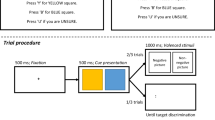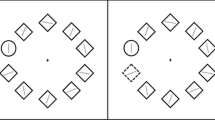Abstract
This review evaluates evidence of attentional biases in generalized anxiety disorder (GAD) and depressive disorder from studies using modified Stroop and visual probe tasks. There appears to be fairly consistent evidence for an attentional bias for external negative cues in GAD, and for the involvement of non-conscious processes in this bias. By contrast, in clinical depression, the evidence for an attentional bias is less robust, despite depressive disorder being commonly associated with high levels of co-morbid anxiety. Where an attentional bias has been found in depressed patients, it seems to occur mainly for self-relevant negative information which is presented under conditions that allow or encourage elaborative processing. Possible explanations for this discrepant pattern of results, and their theoretical and clinical implications are discussed.
Similar content being viewed by others
References
American Psychiatric Association (1987). Diagnostic and statistical manual of mental disorders (3rd ed., Revised). Washington, DC: American Psychiatric Association.
American Psychiatric Association (1994). Diagnostic and statistical manual of mental disorders (4th ed.). Washington, DC: American Psychiatric Association.
Ballenger, J. C. (1999). Current treatments of anxiety disorders in adults. Biological Psychiatry, 46, 1579–1594.
Beck, A. T. (1976). Cognitive therapy and the emotional disorders. New York: International Universities Press.
Beck, A. T., & Emery, G. (1985). Anxiety disorders and phobias: A cognitive perspective. New York: Basic Books.
Beck, A. T., Rush, A. J., Shaw, B. F., & Emery, G. (1979). Cognitive Therapy of Depression: A Treatment Manual. New York: Guilford Press.
Becker, E. S., Rinck, M., Magraf, J., & Roth, W. T. (2001). The emotional Stroop effect in anxiety disorders—general emotionality or disorder specificity? Journal of Anxiety Disorders, 15, 147–159.
Bradley, B. P., Mogg, K., Falla, S. J., & Hamilton, L. R. (1998). Attentional bias for threatening facial expressions in anxiety: Manipulation of stimulus duration. Cognition and Emotion, 12, 737–753.
Bradley, B. P., Mogg, K., Millar, N., & White, J. (1995). Selective processing of negative information: Effects of clinical anxiety, concurrent depression, and awareness. Journal of Abnormal Psychology, 104, 3, 532–536.
Bradley, B. P., Mogg, K., White, J., Groom, C., & de Bono, J. (1999). Attentional bias for emotional faces in generalised anxiety disorder. British Journal of Clinical Psychology, 38, 267–278.
Brown, T. A., Campbell, L. A., Lehman, Grisham, J. R., & Mancill, R. B. (2001). Current and lifetime co-morbidity of DSM-IV anxiety and mood disorders in a large clinical sample. Journal of Abnormal Psychology, 110, 585–599.
Butler, G., Fennell, M., Robson, P., & Gelder, M. (1991). Comparison of behaviour therapy and cognitive behaviour therapy in the treatment of generalized anxiety disorder. Journal of Consulting and Clinical Psychology, 59, 167–175.
Clark, D. M. (1999). Anxiety disorders: Why they persist and how to treat them. Behaviour Research and Therapy, 37, S5–S27.
de Ruiter, C., & Brosschot, J. F. (1994). The emotional Stroop interference in anxiety: Attentional bias or cognitive avoidance. Behaviour Research and Therapy, 32, 315–319.
Eizenman, M., Yu, L. H., Grupp, L., Eizenman, E., Ellenbogen, M., Gemar, M., & Levitan, R. D. (2003). A naturalistic visual scanning approach to assess selective attention in major depressive disorder. Psychiatry Research, 118, 117–128.
Fox, E., Russo, R., Bowles, R., & Dutton, K. (2001). Do threatening stimuli draw or hold visual attention in subclinical anxiety. Journal of Experimental Psychology: General, 130, 681–700.
Golombok, S., Stavrou, A., Bonn, J., Mogg, K., Critchlow, S., & Rust, J. (1991) Effects of diazepam on anxiety-related cognition. Cognitive Research and Therapy, 15, 459–467.
Gotlib, I. H., & Cane, D. B. (1987). Construct accessibility and clinical depression: a longitudinal investigation. Journal of Abnormal Psychology, 96, 199–204.
Kendler, K. S., Neale, M. C., Kessler, R. C., Heath, A. C., & Eaves, L. J. (1992). Major depression and generalized anxiety disorder: Same genes, (partly) different environments? Archives of General Psychiatry, 49, 716–722.
MacLeod, C., Mathews, A., & Tata, P. (1986). Attentional bias in emotional disorders. Journal of Abnormal Psychology, 95, 15–20.
MacLeod, C., Rutherford, E. M., Campbell, L., Ebsworthy, G., & Holker, L. (2002). Selective attention and emotion vulnerability: Assessing the causal basis of their association through the experimental induction of attentional bias. Journal of Abnormal Psychology, 111, 107– 123.
Martin, M., Williams, R., & Clark, D. (1991). Does anxiety lead to selective processing of threat-related information? Behaviour Research and Therapy, 29, 147–160.
Mathews, A., & Macikntosh, B. (1998). A cognitive model of selective processing in anxiety. Cognitive Therapy & Research, 22, 539–560.
Mathews, A., & Sebastian, S. (1993). Suppression of emotional Stroop effects by fear arousal. Cognition & Emotion, 7, 517–530.
Mathews, A., & Klug, F. (1993). Emotionality and interference with colour-naming in anxiety. Behaviour Research and Therapy, 31, 57–62.
Mathews, A., & MacLeod, C. (1985). Selective processing of threat cues in anxiety states. Behaviour Research and Therapy, 23, 563–569.
Mathews, A., & MacLeod, C. (1994). Cognitive approaches to emotion and emotional disorders. Annual Review of Psychology, 45, 25–50.
Mathews, A., & MacLeod, C. (2002). Induced processing biases have causal effects on anxiety. Cognition and Emotion, 16, 331–354.
Mathews, A., Mogg, K., Kentish, J., & Eysenck, M. (1995). Effects of psychological treatment on cognitive bias in generalised anxiety disorder. Behaviour Research and Therapy, 33, 293–303.
Mathews, A., Ridgeway, V., & Williamson, D. A. (1996). Evidence for attention to threatening stimuli in depression. Behaviour Research and Therapy, 34, 695–705.
McCabe, S. B., & Gotlib, I. H. (1995). Selective attention and clinical depression: Performance on a deployment of attention task. Journal of Abnormal Psychology, 104, 241–245.
Mineka, S., Watson, D., & Clark, L. A. (1998). Comorbidity of anxiety and unipolar mood disorders. Annual Review of Psychology, 49, 377–412.
Mogg, K., & Bradley, B. P. (1998). A cognitive-motivational analysis of anxiety. Behaviour Research and Therapy, 36, 809–848.
Mogg, K., & Bradley, B. P. (1999). Some methodological issues in assessing attentional biases for threatening faces in anxiety: A replication study using a modified version of the probe detection task. Behaviour Research and Therapy, 37, 595–604.
Mogg, K., & Bradley, B. P. (in press). A cognitive-motivational perspective on the processing of threat information and anxiety. In J. Yiend (Ed.). Cognition, emotion and psychopathology. Cambridge, Cambridge University Press.
Mogg, K., Bradley, B. P., Williams, R., & Mathews, A. (1993). Subliminal processing of emotional information in anxiety and depression. Journal of Abnormal Psychology, 102, 304–311.
Mogg, K., Bradley, B. P., & Williams, R. (1995). Attentional bias in anxiety and depression: the role of awareness. British Journal of Clinical Psychology, 34, 17–36.
Mogg, K., Mathews, A., & Eysenck, M. (1992). Attentional bias in clinical anxiety states. Cognition and Emotion, 6, 149–159.
Mogg, K., Mathews, A., & Weinman, J. (1989). Selective processing of threat cues in clinical anxiety states: A replication. Behaviour Research and Therapy, 27, 317–323.
Mogg, K., Mathews, A., May, J., Grove, M., Eysenck, M., & Weinman, J. (1991). Assessment of cognitive bias in anxiety and depression using a colour perception task. Cognition and Emotion, 5, 221-238.
Mogg, K., Bradley, B. P., Miles, F., & Dixon, R. (in press). Time course of attentional bias for threat scenes: Testing the vigilance-avoidance hypothesis. Cognition and Emotion.
Mogg, K., Millar, N., & Bradley, B. P. (2000). Biases in eye movements to threatening facial expressions in generalised anxiety disorder and depressive disorder. Journal of Abnormal Psychology, 19, 695-704.
Neshat-Doost, H., Taghavi, R., Moradi, A., Yule, W., & Dalgleish, T. (1997). The performance of clinically depressed children and adolescents on the modified Stroop paradigm. Personality and Individual Differences, 23, 753–759.
Neshat-Doost, H. T., Moradi, A. R., Taghavi, M. R., Yule, W., & Dalgleish, T. (2000). Lack of attentional bias for emotional information in clinically depressed children and adolescents. Journal of Child Psychology and Psychiatry and Allied Disciplines, 41, 363–368.
Nunn, J. D., Mathews, A., & Trower, P. (1997). Selective processing of concern-related information in depression. British Journal of Clinical Psychology, 36, 489–503.
Oatley, K., & Johnson-Laird, P. (1987). Towards a cognitive theory of emotions. Cognition and Emotion, 1, 29–50.
Posner, M. I., Snyder, C. R., & Davidson, B. J. (1980). Attention and the detection of signals. Journal of Experimental Psychology: General, 109, 160–174.
Segal, Z. V., Hood, J. E., Shaw, B. F., & Higgins, E. T. (1988). A structural analysis of the self-schema construct in major depression. Cognitive Therapy and Research, 12, 471–485.
Segal, Z. V., Truchon, C., Gemar, M., Guirguis, M., & Horowitz, L. M. (1995). A priming methodology for studying self-representation in major depressive disorder. Journal of Abnormal Psychology, 104, 205–213.
Shankman, S. A., & Klein, D. N. (2003). The relation between depression and anxiety: An evaluation of the tripartite, approach-withdrawal and valence-arousal models. Clinical Psychology Review, 23, 605–637.
Simons, A. D., Murphy, G. E., Levine, J. L., & Wetzel, R. D. (1986). Cognitive therapy and pharmacotherapy for depression. Archives of General Psychiatry, 43, 43–50.
Suslow, T., Junghanns, K., & Arolt, V. (2001). Detection of facial expressions of emotions in depression. Perceptual and Motor Skills, 92, 857–868.
Taghavi, M. R., Neshat-Doost, H. T., Moradi, A. R., Yule, W., & Dalgleish, T. (1999). Biases in visual attention in children and adolescents with clinical anxiety and mixed anxiety-depression. Journal of Abnormal Child Psychology, 27, 215–223.
Tyrer, P. (1984). Classification of anxiety. British Journal of Psychiatry, 144, 78–83.
Williams, J. M. G., Mathews, A., & MacLeod, C. (1996). The emotional Stroop task and psychopathology. Psychological Bulletin, 120, 3–24.
Williams, J. M. G., Watts, F. N., MacLeod, C., & Mathews, A. (1988). Cognitive psychology and emotional disorders. Chichester: Wiley.
Williams, J. M. G., Watts, F. N., MacLeod, C., & Mathews, A. (1997). Cognitive psychology and emotional disorders. Second Edition. Chichester: Wiley.
Author information
Authors and Affiliations
Rights and permissions
About this article
Cite this article
Mogg, K., Bradley, B.P. Attentional Bias in Generalized Anxiety Disorder Versus Depressive Disorder. Cogn Ther Res 29, 29–45 (2005). https://doi.org/10.1007/s10608-005-1646-y
Issue Date:
DOI: https://doi.org/10.1007/s10608-005-1646-y




